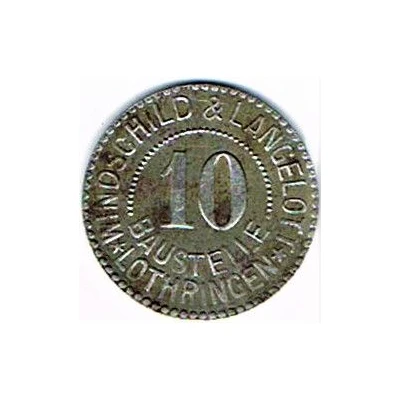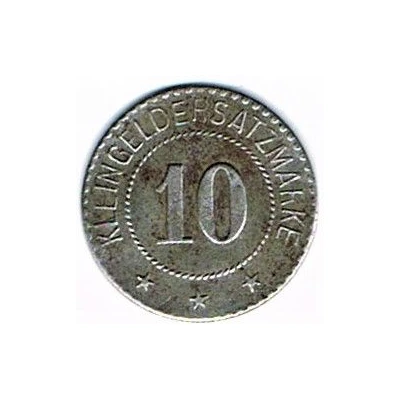


© Kreutzer67 (CC BY-NC-SA)
10 Pfennigs - Windschild and Mangelott - Lothringen 57 ND
| Iron | - | 20 mm |
| Issuer | Imperial territory of Alsace-Lorraine (German notgeld) |
|---|---|
| Emperor | William II (Wilhelm II) (1888-1918) |
| Type | Standard circulation coin |
| Years | 1917-1918 |
| Value | 10 Pfennigs (10 Pfennige) (0.10) |
| Currency | Mark (1914-1924) |
| Composition | Iron |
| Diameter | 20 mm |
| Shape | Round |
| Technique | Milled |
| Orientation | Medal alignment ↑↑ |
| Demonetized | Yes |
| Updated | 2024-10-04 |
| Numista | N#322773 |
|---|---|
| Rarity index | 94% |
Reverse
Script: Latin
Lettering:
KLEINGELDERSATZMARKE
10
***
Edge
Plain
Comment
It is a manufacturer of cement-based products with headquarters in Dresden (Saxony) and subsidiaries in Lorraine (Germany) and the current Moselle département (57).References
- Alain Marchand book page 39 - Monnaies de nécessité et jetons-monnaie d'Alsace et de Moselle (Alsace and Moselle coins and tokens)
- Book Edgar Wendling page 71 - Monnaies de nécessité et jetons fiduciaires et autres dans l'actuel Département de la Moselle
Menzel: BBB
Interesting fact
One interesting fact about this coin is that it was made of iron, which was a common material used for coinage during World War I due to the shortage of other metals. This coin, in particular, was issued by the Imperial territory of Alsace-Lorraine, which was a region that was annexed by Germany during the war. The coin features the image of a windmill and a shield, which symbolize the region's agricultural and industrial heritage. Additionally, the coin's design was created by two artists, Windschild and Mangelott, whose initials are visible on the coin's reverse side.
Price
| Date | Mintage | VG | F | VF | XF | AU | UNC |
|---|---|---|---|---|---|---|---|
| ND (1917-1918) | 3000 | - | - | - | - | - | - |
Values in the table are based on evaluations by sales realized on Internet platforms. They serve as an indication only for 10 Pfennigs - Windschild and Mangelott - Lothringen (57) ND (1917-1918) coin.